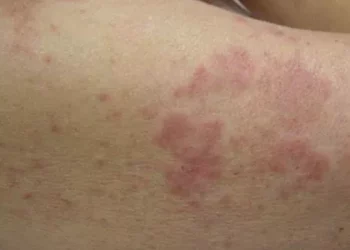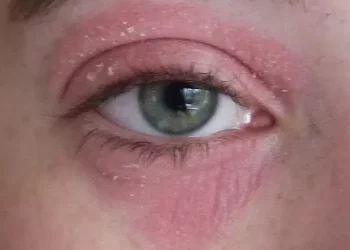Ringworm is a common fungal infection that can affect the skin, scalp, nails, and even the feet. Despite its name, it has nothing to do with worms. It is caused by a group of fungi known as dermatophytes. The infection appears as a red, itchy, ring-shaped rash, which is why it is called “ringworm.” People often wonder if hydrocortisone cream can help treat this condition. In this article, we will explore the role of hydrocortisone cream in treating ringworm, its benefits, limitations, and other treatment options for this fungal infection.
What is Ringworm?
Ringworm is a skin condition caused by a fungal infection. It affects both humans and animals. The infection is highly contagious and can spread through direct contact with an infected person, animal, or contaminated surfaces like towels and clothing.
Ringworm is characterized by a red, circular rash with raised edges and a clearer center, giving it a ring-like appearance. The rash can appear anywhere on the body but is commonly found on the scalp, feet (athlete’s foot), and groin (jock itch).
The fungi that cause ringworm thrive in warm, moist environments, making areas like locker rooms, public showers, and damp clothing prime spots for infection. Individuals with weakened immune systems, poor hygiene, or excessive sweating are more susceptible to ringworm.
How Does Hydrocortisone Cream Work?
Hydrocortisone is a type of corticosteroid, a class of medications that reduce inflammation and alleviate symptoms like redness, itching, and swelling. It works by suppressing the immune system’s inflammatory response, which is why it is commonly used to treat conditions like eczema, psoriasis, and allergic reactions.
Hydrocortisone cream is typically applied topically to the skin. When applied, it penetrates the skin layers and reduces inflammation, providing relief from itching and swelling. This makes it effective in managing symptoms of various skin conditions, but it is important to understand that hydrocortisone does not treat the underlying cause of the infection.
Can Hydrocortisone Help Ringworm?
Hydrocortisone cream is sometimes used to relieve the itching and inflammation caused by ringworm, but it is not a treatment for the fungal infection itself. Ringworm is caused by a fungus, and hydrocortisone does not kill fungi. In fact, using hydrocortisone alone to treat ringworm may only mask the symptoms without addressing the root cause of the infection.
While hydrocortisone can help reduce the redness, itching, and irritation associated with ringworm, it may not completely eliminate the fungus. In some cases, using hydrocortisone on a fungal infection can even make the condition worse. The cream can suppress the immune response temporarily, which may allow the infection to spread more easily or become more resistant to treatment.
Risks of Using Hydrocortisone on Ringworm
Using hydrocortisone cream on ringworm without additional antifungal treatment can lead to several issues:
1. Masking Symptoms
Hydrocortisone provides quick relief from itching and inflammation, which can make the infection feel better temporarily. However, it doesn’t address the cause of the infection. This can delay proper treatment and cause the infection to worsen or spread.
2. Worsening the Infection
In some cases, applying hydrocortisone to a fungal infection can cause the infection to become more aggressive. Fungal infections thrive in areas with reduced immune activity, and corticosteroids like hydrocortisone can suppress the body’s ability to fight the fungus effectively. As a result, the infection may spread further or become more difficult to treat.
3. Skin Thinning
Long-term use of hydrocortisone cream can lead to skin thinning, a condition known as atrophy. This can make the skin more fragile and susceptible to damage, making it harder for the skin to heal after an infection.
4. Secondary Infections
Because hydrocortisone reduces inflammation, it may also suppress the body’s immune response, increasing the risk of developing secondary infections. This can occur if bacteria enter the skin through open sores or cuts caused by scratching the ringworm rash.
Proper Treatment for Ringworm
While hydrocortisone may provide temporary relief from the symptoms of ringworm, it is not the most effective way to treat the infection itself. The best treatment for ringworm is antifungal medication. Antifungal treatments are specifically designed to kill the fungi responsible for the infection.
1. Antifungal Creams
Over-the-counter antifungal creams, such as clotrimazole, terbinafine, or miconazole, are commonly used to treat ringworm. These creams work by targeting the cell walls of the fungi, preventing them from growing and multiplying. It is important to apply these creams to the affected area as directed, usually for two to four weeks, even if the symptoms improve before the full treatment course is completed.
2. Oral Antifungal Medications
In some cases, if the infection is severe or widespread, a doctor may prescribe oral antifungal medications. These medications, such as terbinafine or itraconazole, are taken by mouth and work throughout the body to kill the fungus. Oral antifungals are often necessary for infections on the scalp, nails, or other hard-to-reach areas.
3. Keeping the Skin Clean and Dry
Since fungi thrive in warm, moist environments, it is crucial to keep the affected area clean and dry. Wash the affected area with soap and water, and pat it dry with a clean towel. Avoid tight clothing that can trap moisture, and change clothes frequently to prevent the spread of the infection.
4. Avoiding Scratching
Scratching the ringworm rash can make the infection worse by spreading the fungus to other parts of the body or other people. Try to resist the urge to scratch and keep the area covered with clean, loose clothing to minimize contact.
5. Practicing Good Hygiene
To prevent the spread of ringworm, practice good hygiene. Wash your hands frequently, avoid sharing personal items such as towels, and disinfect surfaces that may have come into contact with the infection.
When to See a Doctor
If you suspect you have ringworm and are not sure how to treat it, or if the infection does not improve with over-the-counter treatments, it is important to see a doctor. A healthcare professional can diagnose the infection and recommend the most appropriate treatment. If the infection is severe or affecting sensitive areas like the scalp or nails, medical intervention may be necessary to prevent complications.
Conclusion
While hydrocortisone cream can help alleviate the symptoms of ringworm, such as itching and inflammation, it is not a cure for the infection itself. The most effective way to treat ringworm is with antifungal medications that target the root cause of the infection. If you have ringworm, it is important to use the right treatment to eliminate the fungus and prevent it from spreading or becoming more severe.
Hydrocortisone should be used with caution and only as a supplementary treatment to help manage symptoms, not as a primary treatment. If you have concerns about your skin or fungal infections, it is always a good idea to consult a healthcare professional for advice on the best course of action. By treating the infection properly and maintaining good hygiene, you can get rid of ringworm and prevent it from coming back.
Related topics
























